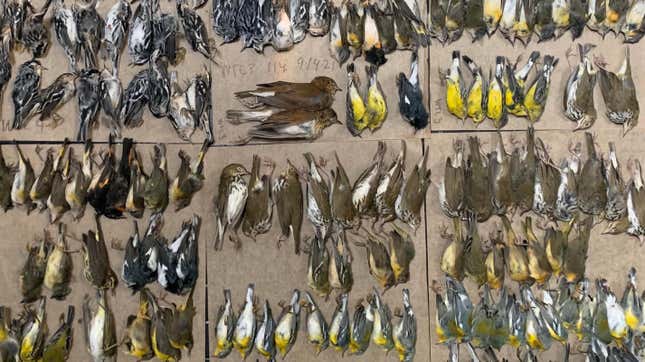
When Melissa Breyer packed up her bag on Monday night for her Tuesday morning volunteer shift with NYC Audubon, she decided to seriously prepare.
Her task wasn’t to take part in a bird count—at least not a count of living birds. She was taking part in Project Safe Flight, an effort to track how many migratory birds die navigating New York. She loaded up her backpack with dozens of plastic bags to carry bird carcasses as well as paper bags outfitted to gingerly transport injured birds to caretakers—several times the number of bags that she normally brings with her on a shift. The forecasts were showing that a lot of migrating birds would be flying into the city on Monday night and Tuesday morning, and she wanted to be prepared.
“I packed my bag, like really packed it, packed it full, full, full, of all the supplies I could,” Breyer, the editorial director of the environmental publication Treehugger, said.
That foresight unfortunately turned out to be prescient. In the two-and-a-half hours Breyer spent surveying the World Trade Center complex in downtown Manhattan beginning at dawn, she spotted hundreds of dead birds. Tuesday was a particularly gruesome day for migratory birds in New York City in what is a dangerous season for winged creatures passing through the city en route to warmer locales for the winter along the Atlantic Flyway.
“As soon as I got there, I saw more birds than I could count in every direction I looked as far as I could see,” she said. “To the right, to left straight ahead, I was just in shock.”
Breyer collected 226 carcasses of birds that had perished after collisions with windows. She also collected 30 injured birds to drop off at the Wild Bird Fund’s bird rescue center. On glass awnings on the World Trade Center buildings, she spotted another 35 birds that died after hitting windows.
The staggering death toll at the one location tallied up in just a few hours was due to a few immediate factors. A big surge of migrating birds came through the city. There was also a storm on Monday night, and turbulent weather can disorient birds and cause them to fly lower, making window collisions more likely.

But bird deaths amid clear weather are common, too. NYC Audubon estimates that up to 230,000 birds die from crashing into windows each year, with upticks during Atlantic Flyway migration season when droves of birds traveling thousands of miles in both hemispheres. Kaitlyn Parkins, associate director of conservation & science with NYC Audubon, said there are two primary drivers of the collisions.
“We get nocturnal collisions that are caused by disorienting lights,” she said. “Birds are attracted to and disoriented by lights, so lights from buildings can bring them into areas where they are at risk of colliding with buildings. On Monday night, we saw a lot of overnight collisions. And then the other reason for the collisions is the reflective glass all over the city. That night, the number of migrants that were here was so high and birds were colliding with windows throughout the morning and even into the afternoon.”
A mass bird mortality event happened last spring, though on a smaller scale than Monday night’s scene at the World Trade Center, when dozens of migratory birds wound up dead outside a glass-sheathed Harlem apartment building. (Rita McMahon, director of Wild Bird Fund, called it a “bloodbath” at the time.)
This isn’t just a problem in New York City, either. Collisions are the second largest bird killer in the U.S., second only to being killed by outdoor cats. Parkins said some estimates indicate as many as 1 billion birds die colliding with windows each year.
These numbers are grim, but we know how to lower them. One important mitigation strategy is to turn off lights at night—a simple step that studies show can drastically reduce deaths. Some Texas municipalities have implemented this strategy on a city-wide level with “lights out” policies. Those policies, though, have been difficult to implement in the so-called city that never sleeps.

Another important fix is to make windows more visible. On that front, New York City has made important progress. In 2019, the City Council passed a law requiring all new buildings’ glass panels to make their glass panels more bird-friendly, including by making them translucent or opaque, or by etching patterns into them to make them more visible. It doesn’t affect existing buildings like the World Trade Center, though, but NYC Audubon is working to change that so more buildings in the city are bird-safe.
If you’re concerned about bird collisions—and frankly, they’re concerning—there are ways you can help as an individual, too. You can turn off your porch lights before you go to sleep each night so birds aren’t drawn to your windows. And you can put adhesive decals on your windows so birds see that they’re there, too. If you’re in New York City, you can also volunteer with Project Safe Flight and help monitor and report bird collisions.
“The only good thing about solutions is that we do know how to fix them,” said Parkins.
Update, 9/15/21, 4:37 p.m. ET: This post has been updated to note Breyer was volunteering with NYC Audubon, not the Audubon Society.